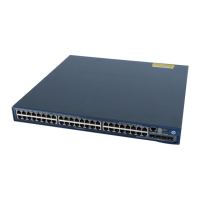177
Setting other LLDP parameters
The Time To Live TLV carried in an LLDPDU determines how long the device information carried in the
LLDPDU can be saved on a recipient device.
By setting the TTL multiplier, you can configure the TTL of locally sent LLDPDUs, which determines how
long information about the local device can be saved on a neighbor device. The TTL is expressed using
the following formula:
TTL = Min (65535, (TTL multiplier × LLDPDU transmit interval))
As the expression shows, the TTL can be up to 65535 seconds. TTLs greater than 65535 will be rounded
down to 65535 seconds.
Follow these steps to change the TTL multiplier:
lldp hold-multiplier value
Set the LLDPDU transmit interval
lldp timer tx-interval interval
Optional
30 seconds by default
Set LLDPDU transmit delay
lldp timer tx-delay delay
Optional
2 seconds by default
Set the number of LLDPDUs sent
each time fast LLDPDU
transmission is triggered
NOTE:
To ensure that the LLDP neighbors can receive LLDPDUs to update information about the current device
before it ages out, configure both the LLDPDU transmit interval and delay to be less than the TTL.
Setting an encapsulation format for LLDPDUs
LLDPDUs can be encapsulated in the following formats: Ethernet II or SNAP frames.
With Ethernet II encapsulation configured, an LLDP port sends LLDPDUs in Ethernet II frames and
processes only incoming, Ethernet II encapsulated LLDPDUs.
With SNAP encapsulation configured, an LLDP port sends LLDPDUs in SNAP frames and processes
only incoming, SNAP encapsulated LLDPDUs.
By default, Ethernet II frames encapsulate LLDPDUs. If the neighbor devices encapsulate LLDPDUs in SNAP
frames, configure the encapsulation format for LLDPDUs as SNAP to guarantee normal communication
with the neighbors.
Follow these steps to set the encapsulation format for LLDPDUs to SNAP:

